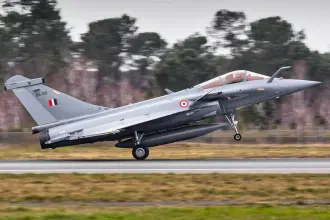Culture
When Folklore Roars: 'Kantara: Chapter 1' Brings Tulu Tales To Life
K Balakumar
Oct 04, 2025, 10:40 AM | Updated 01:11 PM IST
Save & read from anywhere!
Bookmark stories for easy access on any device or the Swarajya app.


When Kantara released in 2022, it was hailed for its rootedness. A local story steeped in Bhoota Kola that managed to cut across India’s linguistic and cultural divides. Director-actor Rishab Shetty's audacity was the talk of the industry.
Now, three years later, he has returned with Kantara: Chapter 1, a prequel that moves several centuries back to the 4th century. If the first film was tight and dramatic, the new one feels more sprawling, less urgent. Yet it marks an unmistakable step up in ambition. The film is mounted with scale and detail on par with fantasy epics like Game of Thrones.
The film plants itself in a tribe that has had no contact with the outside world. They hunt, gather, live by their chants and rituals, a society untouched by notions of trade, metallurgy or agriculture. But the screenplay tracks the first disruptions, the tentative beginnings of farming, the opening up to barter, and the creeping realisation that the forest's bounty is enriching outsiders rather than them. There are darker moments too. They see produce from their sacred land traded away. What was once innocence gives way to suspicion, and slowly, exploitation.
Rishab Shetty frames it almost as an allegory. The loss of a world's first innocence, the rupture that comes when self-contained societies brush up against power and greed.
Visual, production and aural wizardry
This premise might have faltered without strong craft, but Rishab Shetty's team more than delivers. Cinematographer Arvind S Kashyap bathes the screen in fire, smoke, mist and shadow, creating a landscape that feels alive. Wide frames turn forests into Avatar-like believable space and close-ups pulse with fire and sweat during combat scenes.
The gritty battles, staged with hundreds of extras, achieve scale without losing intimacy. The choreography refuses slick stylisation. Instead, fights are raw, bodies clashing in dust and rain. Fire torches whip across frames with dangerous unpredictability. This unpolished ferocity distinguishes Kantara: Chapter 1 from other action films, whose set-pieces often felt like VFX-generated simulacra, kinetic but soulless. Even the CGI here is folded into the organic palette. Forest deities, spectral visions, wild animals, or magical artefacts emerge from believable textures. Nothing screams green-screen excess. The fantasy remains tethered to soil, sky, and sweat.
For a film with its origins in a modest Kannada industry, Kantara: Chapter 1 also dazzles with its production ambition. Costume design recreates centuries-old coastal culture with detail that looks neither plastic nor overly glossy. Weapons, jewellery, and face-mud feel rugged, used, and functional, avoiding the trap of historical cosplay.
Production designer Banglan builds an indigenous world that feels authentic but not archaic. Huts, costumes, and ritual artefacts emerge with anthropological care and cinematic flair. The king's court, for instance, is not some ethnic and sprawling floor of grandeur, but more an interesting room of a cooped-up group of blokes in royal attire (which in themselves are relatively restrained).
And the film’s heartbeat is composer Ajaneesh Loknath, whose music pulsates with drum-heavy ritual crescendos and thunderous chants. His score rarely lets the film sag, and unlike many commercial blockbusters, it feels organic, stitched into the earthiness of the setting. Take the battle montages, the score throbs like ritual drumming, then blooms into operatic crescendos. The result is a film that is often consumed less as story and more as sensory immersion.
Characters in the shadows
Where the film stumbles is in its characters. The narrative unfolds in the dense, sacred forests of Kantara, home to a tribe untouched by external influences. Their peaceful existence is disrupted by the expansionist ambitions of the Bangra kingdom, ruled by King Vijayendra (Jayaram). His son, Kulasekhara (Gulshan Devaiah), embodies the kingdom's oppressive tactics, while his daughter, Kanakavathi (Rukmini Vasanth), introduces a complex emotional layer to the unfolding events.
Rishab Shetty plays the tribal protagonist (Berme), giving a brooding, physical performance.
Unlike Shiva in the first Kantara, Berme is almost deified in this origin story, morally unambiguous and larger than life. When possessed by the spirit of Guliga, Rishab Shetty elevates the spectacle further. Rudra Guliga, Agni Guliga, and other Shiva manifestations bring a sense of cosmic intensity rarely seen in Indian cinema.
On a big screen, Berme’s screams, the resonance of ritual drums, and the layered chants create a physical, almost tactile cinematic experience. Rishab Shetty balances ritual, myth, and raw physicality, making Berme not only a hero but a symbol of the tribe’s spiritual and martial identity.
Among the supporting cast, Rukmini Vasanth's role is the most interesting one but Gulshan Devaiah, usually magnetic, is underutilised in a caricatured role of a depraved ruler. Jayaram adds heft but his role too is barely developed. Compared to the sharp character arcs in the first Kantara, this feels like a step down.
Still, Kantara: Chapter 1 stages sequences that stick. Fire-lit ceremonies, warriors drenched in ash and mud, dances that double as spiritual possession, as Rishab Shetty leans on ritual as theatre. It is here that his vision shines. Rituals and myths are not mere backdrops but central to the narrative. And unlike other mass spectacles that often lean into CGI bombast, Kantara Chapter 1's imagery rarely feels artificial.
Karnataka's folk cosmology to global fantasy stage
In the end, Kantara: Chapter 1 is not flawless. Its narrative over two-and-a-half-hours of runtime is sometimes unconvincing, its characters feel underwritten, and it lacks the emotional punch of its predecessor.
But as an experiment in spectacle rooted in folk imagination, it is significant. It elevates indigenous, regional folklore to a stage previously reserved for mythic franchises. By blending daiva lore and oral ballads with blockbuster production language, Rishab Shetty insists that Karnataka’s folk cosmology can stand shoulder-to-shoulder with Westeros or Middle Earth.
This is no minor cultural shift. Indian cinema has long looked outward for its fantasy grammar. Here, the gaze is reversed. It mines local soil and ritual, then exports it through cinematic craft. In doing so, it not only revitalises regional storytelling but asserts its universality. The story of Berme and his pact with spirits may be rooted in Tulu land, but it resonates as an archetype. Man and land, gods and justice, betrayal and redemption.





